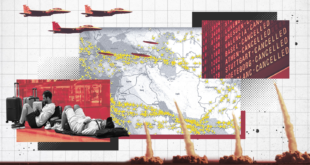OCCUPIED JERUSALEM — So far Israel’s withdrawal from Gaza is as significant for what did not happen as for what did.
No major attacks from Palestinians. No use of weapons by settlers. No significant disruption of life inside Israel. No mass refusal of soldiers to carry out orders.
The army credits excellent preparation and training for the relatively smooth pullout. But there are deeper reasons, too: Palestinians don’t want to endanger the return of their land, and Israelis are reluctant to raise a hand against their own army.
Israel’s historic pullout from the Gaza Strip and parts of the northern West Bank is playing out with lightning speed: An operation that was supposed to take a month was nearly complete in several days. By the weekend, 19 of 25 settlements slated for evacuation had been emptied.
It hasn’t gone off without a hitch, to be sure. Protesters hurled skin-burning paint thinner at troops at the isolated settlement of Kfar Darom, a settler with an M-16 rifle threatened to shoot soldiers and hundreds of anguished youths kicked and locked arms to fight forces hauling them out of Gaza’s largest synagogue.
Still, Jewish extremists are well aware that the perception of an easy pullout could create momentum for further Israeli withdrawals from the West Bank. That increases the incentive to attack in the remaining days of the pullout, which the government hopes will be wrapped up by Tuesday.
In recent days, a 19-year-old soldier in northern Israel shot dead four Arab Israelis on a bus, and a Jewish settler in the West Bank killed four Palestinian labourers in a shooting rampage. Authorities fear extremists might try to stage an even more spectacular attack to show that withdrawals exact a price.
Among the biggest nightmare scenarios is an attack against the holy sites in Jerusalem. A major attack there could ignite the entire Middle East, let alone torpedo Israeli land concessions.
At the moment, the main danger appears to come from Jewish extremists who feel Israeli Prime Minister Ariel Sharon has betrayed a divine promise, that the land belongs to the Jews.
Still to be evacuated next week are two settlements in the northern West Bank, Sanur and Homesh, where residents and their supporters are expected to pose stiff resistance.
They see giving up West Bank land — the heart of biblical Israel — as particularly egregious.
“Over there we’re talking about a lot of vigilantes,” said Israeli military spokeswoman Sharon Feingold. “We hope very much that we will not have extreme situations there, but it’s a different story.” Palestinian extremists also have a motive for violence: To create the impression that Israel is withdrawing under fire. But if they were going to stage a major attack during the Gaza pullout they probably would have done so already.
As of Friday, the Gaza evacuation was 87 per cent complete, according to police.
Gaza’s 1.3 Palestinians have suffered greatly during the past five years of Israeli-Palestinian violence.
The factions have announced they’ll allow the pullout to proceed, aware of ordinary Palestinians’ yearning for a better life in post-Israel Gaza.
Also helping mitigate against is the surprisingly effective cooperation between Israeli and Palestinian security forces. “On the ground, army officers on both sides are working very well together,” said senior Sharon adviser Assaf Shariv.
So far, the Israeli military’s largest noncombat mission has been characterised by great restraint by the troops and only limited violence from the protesters. Aside from the ubiquitous scenes of troops hauling away screaming protesters by their arms and legs, settlers and soldiers also hugged each other and cried together.
“Soldiers are behaving in a most incredible way, and I think this is the preparations that we put them through,” said Feingold. “Especially the psychological and mental preparations are bearing fruit.” The army’s show of overwhelming force also undoubtedly played a role. Some 55,000 security forces are involved in the operation, evacuating numerous settlements at the same time. Four soldiers dragged out each resisting settler, each carrying a limb.
Jewish and Israeli unity also helps explain the lack of significant violence, said political analyst Mark Heller.
“I think in the back of everyone’s mind is a clear understanding that Israel is still in a hostile environment, still faces all kinds of threats,” he said.
Before the pullout began, many had predicted that withdrawal opponents would tie up traffic throughout the country and destroy parts of Israel’s infrastructure. That hasn’t happened, perhaps because the operation’s speed caught protesters off guard. In addition, many extremists infiltrated into Gaza to make a last stand, allowing security forces to deal with them inside rather than divert forces throughout Israel.
The compassion with which Israeli troops treated Jewish settlers was painful to watch for Palestinians who have suffered at the hands of Israeli forces.
Palestinian senior negotiator, Saeb Erekat, asked, “If they were Palestinians in this position how would the Israeli army treat them?”
 Eurasia Press & News
Eurasia Press & News


